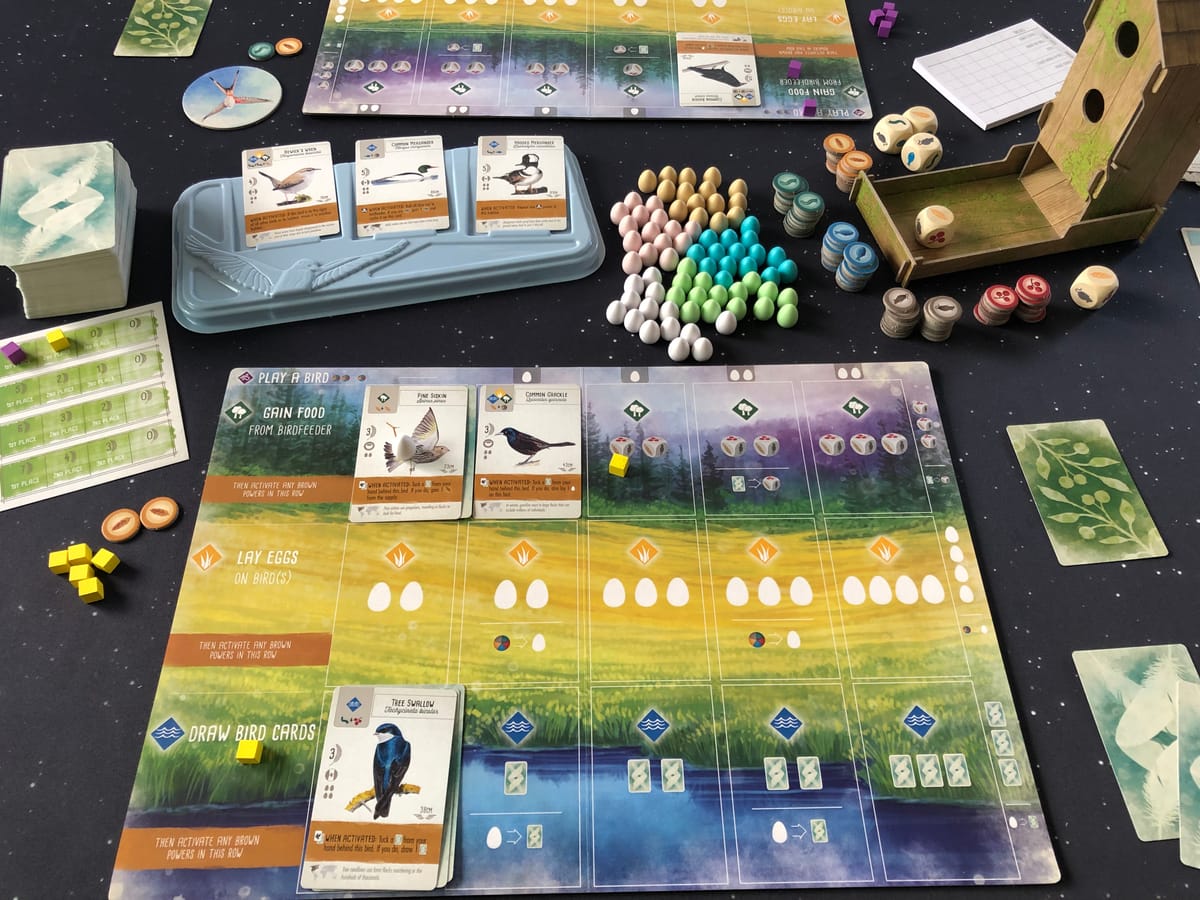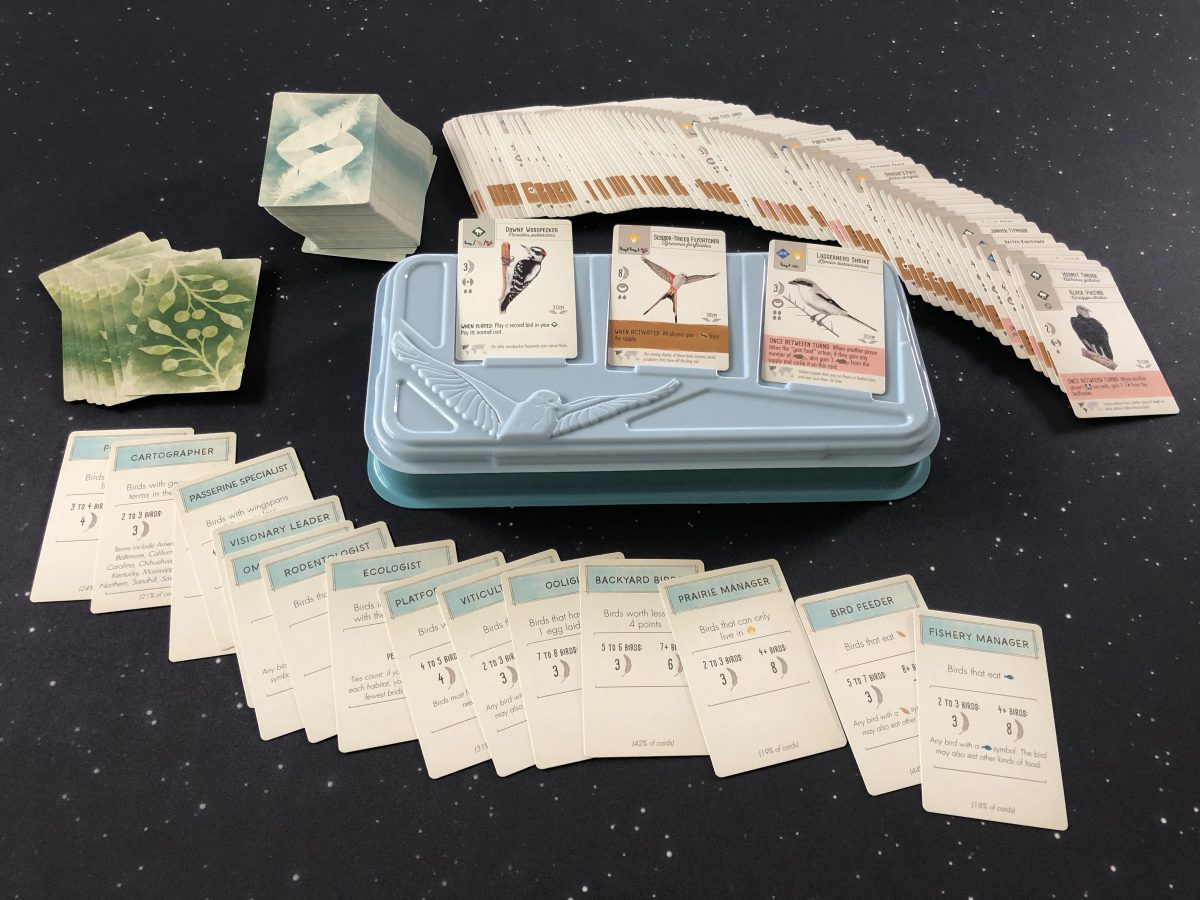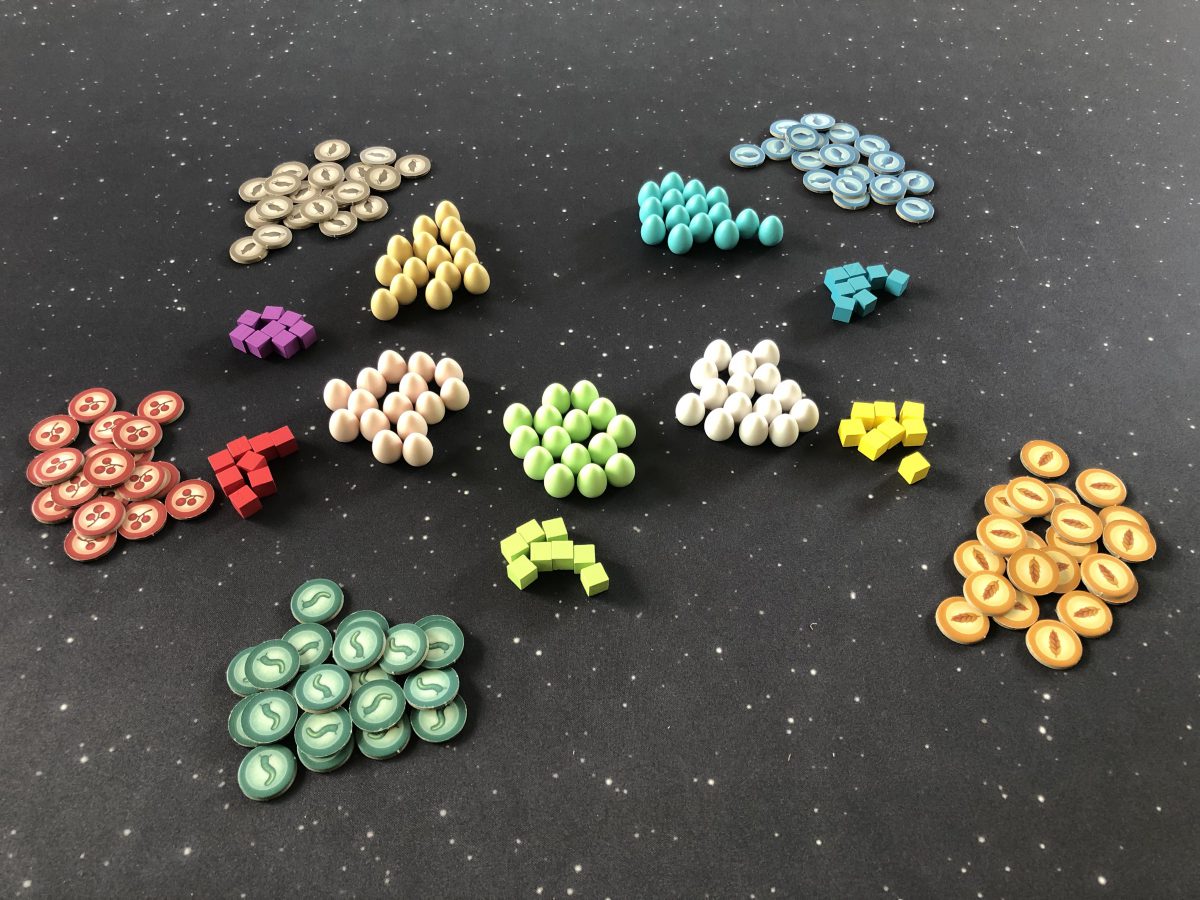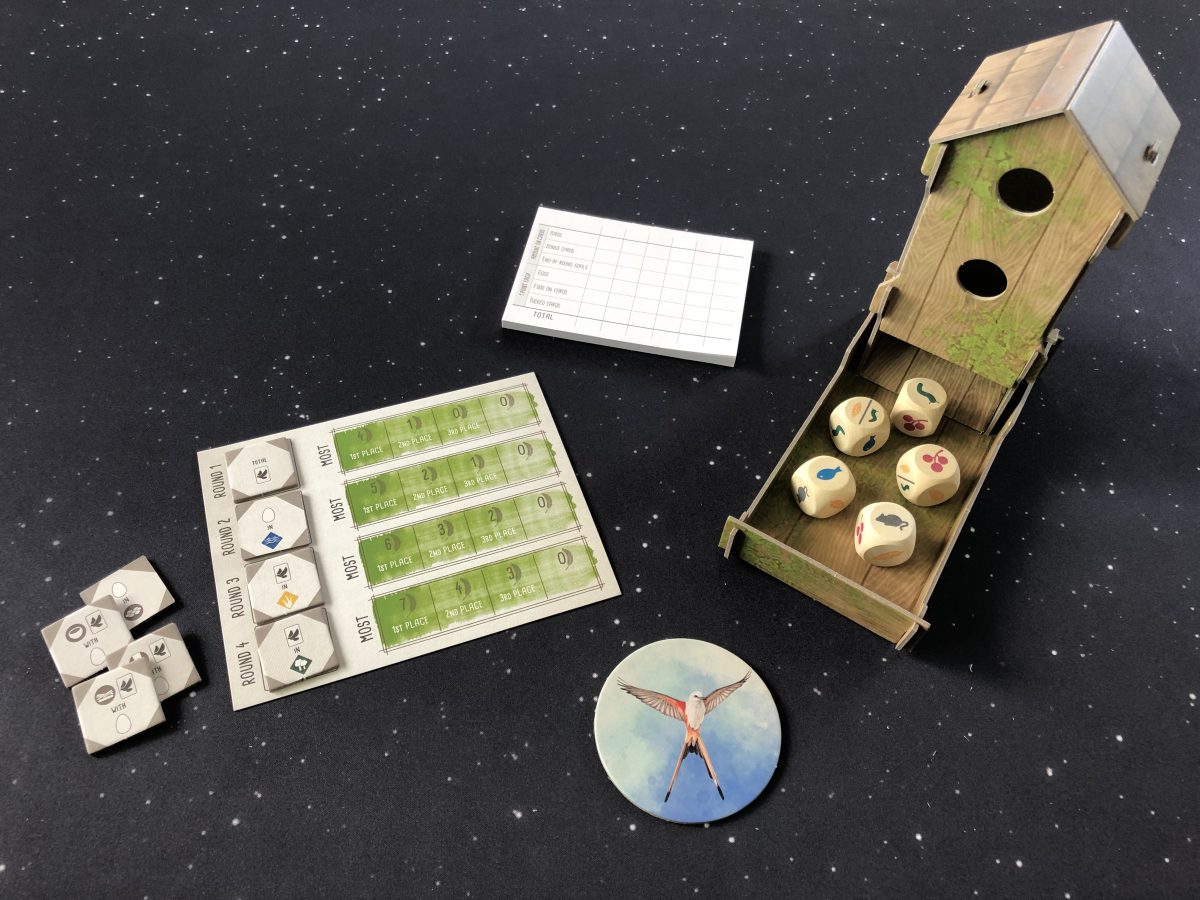
Flocks of birds wheel and turn through the air while a group of enthusiasts try to coax them into their aviaries. You are a bird enthusiast and this is the chance for you to outdo your competitors and develop the greatest collection of North American birds. From ducks paddling in the marshy waters to owls silently winging through the treetops and flocks of birds in between, your ability to assembly a menagerie of complimentary birds will determine if you are the better birder than your fellows. The avian theme runs strong throughout all aspects of Wingspan, designed by Elizabeth Hargrave and published by Stonemaier games. Each round of Wingspan you will attempt to fill your aviary with birds that, in turn, provide you benefits and ultimately help you to score points with which you win the game. If you like birds, then you are in for a treat, if you never thought much about them, this may open your eyes to the beautiful avian world just outside your window, and if you don’t like birds, well, this might change your mind.
The box is graced with a magnificent illustration of a Scissor-Tailed Flycatcher (I learned this playing the game) and comes chock full of bird-themed components that immediately immerse you in this avian world. The 170 bird cards are the backbone of the bird theme. Each has a beautiful, colorful, lifelike, illustration of a North-American bird. Apart from the name and illustration, the cards contain a wealth of information about the bird that is relevant to gameplay, including the bird’s diet, habitat, nest type, amount of eggs each nest can hold and any special benefits that the card provides when played or once it is in play. There are over a hundred food tokens, representing the five general food types that the birds eat: fruit, invertebrates, rodents, seeds, and fish. 75 egg miniatures represent, well, eggs; they come in five different colors, but that seems to have no bearing on gameplay at this time. There are forty wooden cubes, five groups of eight, for the players to use to keep track of their actions each round. The game comes with five custom wooden dice that have one of the five types of food on each face, with the sixth face providing a choice between invertebrates or seed (meaning there are more seeds and bugs available to feed birds). There are some additional game pieces, including a goal board, eight goal tiles, five player boards, twenty six bonus cards, a scorepad, a first player token, and some cards used to run the single player version of the game. In the area of non-essential-but-cool components there is a molded plastic tray, themed with the Flycatcher again, that stores the cards that come in the game and also provides a handy place to set three single cards during gameplay. Finally, there is a bird-house styled, cardboard, dice tower. The components, when laid out on the table, tell even the most casual observer that this game is all about birds.
Learning the game is a relatively simple process – it does not take long to read through the Wingspan rulebook, set up a game and get to bird collecting. Up to five players start the game each with a player mat, some food, a few birds from the deck, and a bonus card to shoot for. The game consists of four turns, each broken down into a series of rounds taken by each of the players. During a round a player chooses from one of four distinct actions, represented on their player mat by four different zones: the sky, the forest, the grasslands, and the wetlands. Placing an action cube in the sky lets the player place a bird card from their hand into one of the other three habitats (forest, grasslands, or wetlands). An action cube placed in the forest gains the player food. Putting an action cube in the grassland lets a player put eggs on birds already in their habitats. Putting an action cube in the wetlands gains the player more bird cards from the main deck of bird cards. After placing an action cube in a habitat that has birds in it, the player moves the cube from right to left across the birds in the habitat to activate powers that each bird may have that give additional bonuses to the player. So, as the game progresses and more birds come into play, each action taken in a region will have the net effect of more bird powers activated, with a potential of 5 birds in each habitat. At the end of each round, players compare their results with the randomized goals on the goal board and collect points. Bonus cards detail how a player can earn bonus points for collecting certain types of birds and they can be a real boon to a player that lucks out on the birds they have available to them, or if they draw a bonus card late in the game that is particularly applicable to the birds they already have. Birds in play can collect points for players by storing food tokens on them or collecting bird cards under them, usually as a result of powers activated when a habitat is used. At the end of the game, the points earned on the goal board combine with the point values of each bird card played, the eggs the player has on birds, and the other points generators (stored food and bird cards) to find the grand total and the winner.
The simple, streamlined gameplay offered by placing cubes on the mat in a habitat and moving them to the left across the birds in that habitat opens the door to a complex set of interactions that will quickly have you making tough decisions on how best to spend your actions. All the actions rely on the other actions to enable them, so no matter what you choose, there will always be another action you will wish you could have done beforehand to make this current action better. Playing a bird is a simple matter of choosing a bird from your hand and playing it – if you can meet the food requirements stated on the card. To gain the food you need to play birds you need to choose the gain food action, but you only gain one food if there are no birds in your forest habitat, so to make that better, you need to play birds there.
As you add more birds to your habitats, you must pay eggs to place the birds. Your first is free, second and third require one egg each and the fourth and fifth birds require two eggs each, so you’ll want to get more eggs by selecting the lay egg action. Just like the gain food action, you get more eggs with more birds in the habitat. To have birds in your hand to put into the habitats, you need to draw cards, which means you need to play in the wetlands and draw cards. Again, same story, you need more birds in the environment to draw more than one card. So, after the first few actions, you’ll find yourself balancing your choices between drawing cards to fill your hand, getting eggs and food to enable playing cards and reaping benefits from played bird cards. At the end of each of the four rounds, the players each give up an action cube, which then conveniently serves to track scores for that round, reducing the total number of actions available each round by one. Building an engine that combines the benefits of playing in a habitat with the powers triggered on each bird in that habitat makes for a dizzying swirl of actions and reactions that require attention to detail, hand management and study of the available birds in the deck, your goals for the turn, and your bonus for the end of the game.
Wingspan is one of the best engine-building games I’ve come across, but it may suffer a little from putting players in the position of vying to build the best engine without much player interaction. Players can try to affect their opponents by limiting the food that is available to them or scooping up cards they may need, but really, players would be best served trying to maximize their own point generation, especially in multiplayer games where negatively impacting one opponent is generally not as helpful as boosting your own score. The goal card has two sides, providing two different ways to tally up the overall score. One side, the green one, rank orders players and doles out points based on 1st, 2nd, 3rd, and 4th place. The other side, the blue one, simply allocates points based on achieving goals. Using the green side makes the game more competitive, since a player that places higher by achieving more towards a given goal earns substantially more points than the others. Using the blue side provides a closer point range because the players aren’t ranked. Neither scoring method really has any bearing on gameplay.
The bird cards provide a little extra information about the birds, including the Latin name of the bird, a bit of trivia about it, and a map of where it can be found. The titular wingspan of each bird is on each card as well. The wingspans of the birds come into play in a few areas: they are used for scoring, for instance you might get points for all birds on your player mat with wingspans over 65cm; and they are used to determine which birds might be eaten by the hunting birds, determined by flipping the top card off of the bird deck and putting small enough birds under your hunter on your game mat. This scoring system works for other traits on the bird cards – flocking birds collect other cards too, points might be allocated for water birds, birds that eat fish, birds that have bowl-shaped nests, etc. While many find the challenge of maximizing these points to be the fun of the game, it’s in this wild variety of point combinations that some players may tune out.
In fact, this one can be a brain-burner – few choices in the game are easy, especially when it comes to deciding what is the best use of bird cards. Of the 170 cards in the game, a player will always be playing with one or two cards fewer in hand than they would like. The complicated interactions between hand management, habitat management, and point management lead to thoughtful and ponderous gameplay, as each player has to evaluate not only the immediate impact of any action taken, but the long-term implications of where a bird card ends up – in the forest, grassland, discard, or tucked up under another bird for points at the end of the game.
Some players may be overwhelmed and find it difficult to make a decision, slowing the game down by dealing with information overload and difficulty committing to an action. But, once players have run through a few rounds and no longer need to constantly reference the rulebook, they will most likely find the handy Appendix more useful with its complete list of powers and explanation of scoring systems and other information. The speed of the turns does not vary much, even though the players take fewer actions because there are more birds in play each round, requiring more power activations and a little more thought with each action taken. The game moves quickly and most groups should find it ranging about an hour to an hour and a half for a complete experience.
There is a single-player option that comes with the game, based on the engine that was built for the boardgame Viticulture. It’s a set of cards and instructions that determine how an artificial opponent called an Automata can randomly earn points at a rate similar to that of human opponents. Playing against the Automata is as challenging as playing against other players, even if lacking in pleasant conversation. It’s scalable, so starting with an easy artificial opponent is a good way to get your feet wet, then moving on to tougher levels helps you to hone your skills, if not win. The Automata does randomly earn points and it is based a little on how well you do, so there is some effect from your strategy during play and you should see improvement in your skills with repeated plays. Otherwise, you could simply play to beat a set score, which might get you the same results but would be less interesting.
Wingspan
Excellent
Wingspan is a complete bird-themed experience that treats the players to a brain-burning hour or so of strategizing and planning. Simple systems interconnect to challenge players and create new situations with every play. Hats off to the graphic designers and artists who help transform a solid set of rules into an eye pleasing, immersive, avian experience. The 170 different birds in the deck provide a plethora of options and variety that make each playthrough a new experience, combined with the random goals and random player bonuses, players should be able to revisit this game many times before feeling like they are covering the same ground again. I highly recommend this game and encourage everyone to give it a try, bird fan or not.
Pros
- Beautiful production and design.
- Excellent engine building.
- Single-player experience is well implemented.
Cons
- Can feel like multiplayer solitaire.





